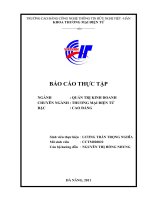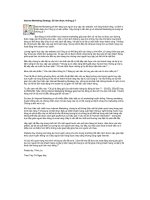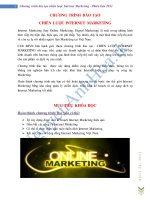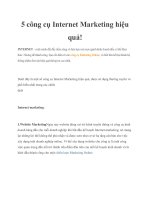Internet marketing textbook
Bạn đang xem bản rút gọn của tài liệu. Xem và tải ngay bản đầy đủ của tài liệu tại đây (3.4 MB, 209 trang )
ACCA APPROVED
CONTENT PROVIDER
FIA Passcards
FIA FAB / ACCA Paper F1
Accountant in Business
Passcards for exams from
1 September 2015 – 31 August 2016
FI31PC15.indd 1
23/03/2015 12:39
(000)FI31PC15_FP_Ricoh.qxp
3/26/2015
FIA FAB
ACCA Paper F1
Accountant in Business
8:45 AM
Page i
(000)FI31PC15_FP_Ricoh.qxp
3/26/2015
8:45 AM
First edition 2011, Fourth edition March 2015
ISBN 9781 4727 3542 3
e ISBN 9781 4727 2875 3
British Library Cataloguing-in-Publication Data
A catalogue record for this book is available from the
British Library
Published by
BPP Learning Media Ltd,
BPP House, Aldine Place,
142-144 Uxbridge Road,
London W12 8AA
www.bpp.com/learningmedia
Page ii
All rights reserved. No part of this publication may be
reproduced, stored in a retrieval system or transmitted, in
any form or by any means, electronic, mechanical,
photocopying, recording or otherwise, without the prior
written permission of BPP Learning Media.
Printed in the United Kingdom by
Ricoh UK Limited
Unit 2
Wells Place
Merstham RH1 3LG
Your learning materials, published by BPP Learning
Media Ltd, are printed on paper obtained from traceable
sustainable sources.
©
BPP Learning Media Ltd
2015
(000)FI31PC15_FP_Ricoh.qxp
3/26/2015
8:45 AM
Page iii
Preface
Contents
Welcome to BPP Learning Media's FIA FAB/ACCA F1 Passcards.
They save you time. Important topics are summarised for you.
They incorporate diagrams to kick start your memory.
They follow the overall structure of the BPP Learning Media Interactive Texts, but BPP Learning Media's
new Passcards are not just a condensed book. Each card has been separately designed for clear
presentation. Topics are self contained and can be g rasped visually.
Passcards are just the right size for pockets, briefcases and bags.
Passcards focus on the exam you will be facing.
Run through the complete set of Passcards as often as you can during your final revision period. The day
before the exam, try to go through the Passcards again! You will then be well on your way to completing your
exam successfully.
Good luck!
Page iii
(000)FI31PC15_FP_Ricoh.qxp
3/26/2015
8:45 AM
Page iv
Preface
Contents
Page
1
Business organisations and their
stakeholders
1
2
The business environment
5
3
The macroeconomic environment
17
4
Microeconomic factors
29
5
Business organisation, structure
and strategy
43
6
Organisational culture and committees
51
7
Corporate governance and social
responsibility
57
8
The role of accounting
65
9
Control, security and audit
75
Page
10
Identifying and preventing fraud
83
11
Leading and managing people
93
12
Recruitment and selection
107
13
Diversity and equal opportunities
123
14
Individuals, groups and teams
131
15
Motivating individuals and groups
139
16
Training and development
151
17
Performance appraisal
163
18
Personal effectiveness and
communication
173
19
Ethical considerations
189
(001)FI31PC15_CH01.qxp
3/17/2015
8:43 PM
Page 1
1: Business organisations and their
stakeholders
Topic List
Types of business organisation
Stakeholders
This chapter explains why organisations are formed and
considers some of the different types of organisation.
Organisations are influenced by stakeholders. The
second part of this chapter identifies different stakeholder
groups, and considers how management may respond to
these groups.
(001)FI31PC15_CH01.qxp
3/17/2015
8:43 PM
Page 2
Types of business
organisation
Stakeholders
Organisation
'A social arrangement which pursues collective goals, which controls its own performance and which has a
boundary separating it from its environment.'
Points of difference
They enable people to be more
PRODUCTIVE:
Overcoming individual limitations
Saving time
Accumulating and sharing knowledge
Enabling synergy
Enabling specialisation
Ownership – public or private sector
Control – owners, workers or government
Activities
Profit orientation – or not
Legal status – limited company/partnership
Size – small or multinational
Sources of finance
Technology usage
Other organisation types to consider are co-oper ative societies, mutual associations and non-governmental
organisations (NGOs).
(001)FI31PC15_CH01.qxp
3/17/2015
8:43 PM
Page 3
Types of business
organisation
Stakeholders
Stakeholders
Those individuals or groups that have an interest in what the organisation does .
Internal
Contractual
relationships
Employees
Management
Connected
External
Shareholders
Customers
Suppliers
Financiers
Community
Government
Pressure groups
Contractual
relationships
Each of these groups has its own particular interests to defend, such as:
Jobs (employees)
Loan security (financiers)
Different interests and aims can lead to conflict
Tax revenues (governments)
Page 3
1: Business organisations and their stakeholders
(001)FI31PC15_CH01.qxp
3/17/2015
8:43 PM
Page 4
Types of business
organisation
Stakeholders
Mendelow suggests that stakeholders may be positioned on a matr ix.
LEVEL OF INTEREST
Low
High
High
C
D
A
B
POWER
Low
Key players are to be found in segment D
Those in segment C should be kept satisfied
Those in segment B should be kept informed
Minimal effort should be expended on segment A
(002)FI31PC15_CH02.qxp
3/19/2015
1:38 PM
Page 5
2: The business environment
Topic List
Analysing the environment
Employment protection
Data protection
Health and safety protection
Social, cultural and technological
trends
Porter
An organisation has many interactions with its
environment, and general environmental trends can be
usefully summarised in the PEST model. The PEST
model is here drawn out into its component par ts.
The chapter concludes with the competitive forces which
can shape the organisation, and the value chain within it.
(002)FI31PC15_CH02.qxp
Analysing the
environment
3/19/2015
Employment
protection
1:38 PM
Data
protection
Page 6
Health and
safety protection
Social, cultural and
technological trends
All organisations must take account of
the environment in which they operate.
POLITICS
TECHNOLOGY
COMPETING
ORGANISATIONS
MATERIALS
SUPPLIERS
LABOUR
CAPITAL
ECONOMY
GENERAL
ENVIRONMENT
ORGANISATION
GOODS TO
CUSTOMERS
WAGE TO
LABOUR
PROFIT TO
INVESTORS
SOCIETY
(& CULTURE)
POLLUTION
Porter
(002)FI31PC15_CH02.qxp
3/19/2015
1:38 PM
Page 7
Legal factors affecting all companies
Factor
Example
General legal framework:
contract, tort, agency
Basic ways of doing business, negligence proceedings
Criminal law
Theft, insider dealing, bribery, deception
Company law
Directors and their duties, reporting requirements, takeover proceedings, shareholders' rights,
insolvency
Employment law
Trade Union recognition, Social Chapter provisions, minimum wage, unfair dismissal,
redundancy, maternity, Equal Opportunities
Health and Safety
Fire precautions, safety procedures
Data protection
Use of information about employees and customers
Marketing and sales
Laws to protect consumers (eg refunds and replacement, 'cooling off' per iod after credit
agreements), what is or isn't allowed in advertising
Environment
Pollution control, waste disposal
Tax law
Corporation tax payment, Collection of income tax (PAYE) and National Insurance
contributions, sales tax (VAT)
Page 7
2: The business environment
(002)FI31PC15_CH02.qxp
Analysing the
environment
3/19/2015
Employment
protection
1:38 PM
Data
protection
Page 8
Health and
safety protection
Social, cultural and
technological trends
Porter
There are several ways in which the government can affect the economic structure of an industry, by
encouraging or stifling:
Role is felt in:
Capacity expansion
Demand for goods and services
Divestment strategies
Emerging industries
Entry barriers
Competition
Product standards
Environmental protection
Monetary policy
R&D
Regional policy
Labour costs
Political change complicates the planning activities of man y firms, and this is par ticularly felt in international
trade – higher level of political risk.
(002)FI31PC15_CH02.qxp
Analysing the
environment
3/19/2015
Employment
protection
1:38 PM
Data
protection
Page 9
Health and
safety protection
Social, cultural and
technological trends
Porter
Much legislation has been aimed at this area.
Legislation
Retirement
Resignation
Dismissal – wrongful
– unfair
Disciplinary procedures
Redundancy
Equal opportunities
Page 9
Companies must be very careful when
handling these matters.
Note that you will not be examined on specific
legislation and exam questions will not be
country specific.
2: The business environment
(002)FI31PC15_CH02.qxp
Analysing the
environment
3/19/2015
Employment
protection
1:38 PM
Data
protection
Page 10
Health and
safety protection
Social, cultural and
technological trends
Porter
The main legislation in the UK is the Data Protection Act 1998 co vered here as an example of 'typical' data
protection legislation.
Data Protection Principles
1
Personal data shall be processed fairly and lawfully
2
Obtained only for specified and lawful purposes
3
Adequate, relevant and not excessive
4
Accurate and up-to-date
5
Not kept for longer than necessary
6
Processed in accordance with the r ights of data subjects
7
Appropriate measures shall be taken against unauthorised use
8
Shall not be transferred to a country where data protection rights are not upheld
The Act also establishes rights for data subjects
Compensation
Correction of data
Access to data held
Sue (damages)
(002)FI31PC15_CH02.qxp
Analysing the
environment
3/19/2015
Employment
protection
1:38 PM
Data
protection
Page 11
Health and
safety protection
Employers and employees have duties and obligations.
Although laws differ in different countries, the main points
and principles are often similar.
Employer duties
All work practices must be safe
Environment must be safe
Plant/machinery maintained
Training
Communication of policies
Risk assessments and controls
Share information
Identify those most at risk
Employ competent advisers
Page 11
implement
and
promote
Social, cultural and
technological trends
Porter
Employee duties
Take reasonable care
Allow employer to carry out duties
Not interfere with machinery
Inform employer of dangers
Use all equipment properly
Health and safety policy
Statement of principles
Detail of safety procedures
Compliance with the law
Detailed equipment instructions
Training requirements
2: The business environment
(002)FI31PC15_CH02.qxp
Analysing the
environment
3/19/2015
Employment
protection
1:38 PM
Data
protection
Page 12
Health and
safety protection
Social, cultural and
technological trends
Porter
Population affects an organisation's supply of labour and hence its human resources policies . Cultural trends will
also have an impact on a business and demand for its products/services.
Factors to consider
Changing age structure
Women participating
Older workers
Family life cycle
Social structures/class
Buying patterns
Income and wealth
Health and diet
Equal opportunities
Environmentalism
(002)FI31PC15_CH02.qxp
3/19/2015
1:38 PM
Technology has often resulted in reduced staff
reduced layers: 'flatter' organisations
Page 13
reduced spans of control;
Information systems such as intranets
can help to foster unity and coherency
Centralised systems
Decentralised systems
Effects of IT on organisations
Routine processing is quicker
Digital information is easily sorted
Employee skills base changing
Continued change to keep up
Customer service enhanced
Information as a 'commodity'
Email, voicemail, video-conferencing
Outsourcing of operations to specialists
Page 13
For the employee it can lead to information
overload, and changes in the nature of
work, but it also fosters close business
relationships regardless of geographical
location, and more flexible working
arrangements.
2: The business environment
(002)FI31PC15_CH02.qxp
Analysing the
environment
3/19/2015
Employment
protection
1:38 PM
Data
protection
Page 14
Health and
safety protection
Social, cultural and
technological trends
Porter
The value chain
The value chain model is one way of analysing what a fir m does – and how it organises and performs its
activities in order to add value.
HUMAN RESOURCE MANAGEMENT
TECHNOLOGY DEVELOPMENT
MA
RG
SUPPORT
ACTIVITIES
FIRM INFRASTRUCTURE
IN
PROCUREMENT
MA
MARKETING
& SALES
SERVICE
PRIMARY ACTIVITIES
The margin is what the customer pays over and above the costs to the fir m.
N
RG
I
INBOUND OPERATIONS OUTBOUND
LOGISTICS
LOGISTICS
(002)FI31PC15_CH02.qxp
3/19/2015
1:38 PM
Page 15
Activity
Comment
Inbound logistics
Receiving, handling and storing inputs to the production system: warehousing,
transport, inventory control and so on.
Operations
Convert resource inputs into a final product. Resource inputs are not only
materials. People are a resource especially in ser vice industries.
Outbound logistics
Storing the product and its distr ibution to customers: packaging, testing, delivery
and so on.
Marketing and sales
Informing customers about the product, persuading them to b uy it, and enabling
them to do so: advertising, promotion and so on.
After sales service
Installing products, repairing them, upgrading them, providing spare parts and so
forth.
Procurement
Acquire the resource inputs to the pr imary activities (eg purchase of mater ials,
subcomponents equipment).
Technology development
Product design, improving processes and/or resource utilisation.
Human resource management
Recruiting, training, developing and rewarding people.
Firm infrastructure
Planning, finance, quality control: Porter believes they are crucially important to an
organisation's strategic capability in all primary activities.
Page 15
2: The business environment
(002)FI31PC15_CH02.qxp
Analysing the
environment
3/19/2015
Employment
protection
1:38 PM
Data
protection
Porter's five forces model
Page 16
Health and
safety protection
Social, cultural and
technological trends
Potential
entrants
Threat of
new entrants
Suppliers
Bargaining
power of
suppliers
Industry competitors
Rivalry among
existing firms
Threat of
substitute products
or service
Substitute
Bargaining
power of
customers
Customers
Porter
(003)FI31PC15_CH03.qxp
3/19/2015
9:05 AM
Page 17
3: The macroeconomic environment
Topic List
Government policies and objectives
The business cycle
National income and economic growth
Inflation and unemployment
Fiscal and monetary policy
The balance of payments
Macroecomonics is a branch of economics which
considers the economy as a whole.
This chapter presents an overview of the goals of
macroeconomic policy. Macroeconomic policy objectives
relate to economic growth, inflation, unemployment and
the balance of payments, looking at the complete
national economy.
(003)FI31PC15_CH03.qxp
Government policies
and objectives
3/19/2015
The business
cycle
9:05 AM
Page 18
National income
and economic growth
Inflation and
unemployment
Fiscal and
monetary policy
The balance of
payments
There is a circular flow of income in the economy.
Expenditure, output and income will all have the same total value.
Income (Y)
Households
Consumption (C)
Firms
Total expenditure (E)
Saving (S)
Financial
sector
Taxation (T)
Government
sector
Import demand (M)
Foreign
sector
Investment spending (I)
Government spending (G)
Export demand (X)
(003)FI31PC15_CH03.qxp
3/19/2015
9:05 AM
Page 19
All modern governments are expected to manage their national economies to some e xtent.
Objectives of economic
policy
To achieve economic
growth – an increase in
national income
To control price inflation
To achieve full employment
To achieve a balance
between exports and
imports (known as the
balance of payments)
Page 19
Government influences over company decisions
Decision
Comment
Output capacity
Grants or tax incentives to invest
Competition
Forbid or allow takeovers/mergers
Outlaw anti-competitive practices
Opening markets to new entrants (eg gas)
Monopolies
Break them up; regulate them
Sales demand
Government policy affects demand
Health and safety
Legislation, regulations
Employment
Equal opportunities legislation
Consumers
Product safety standards
Tax
Sales tax procedures, income tax, accounting control
3: The macroeconomic environment
(003)FI31PC15_CH03.qxp
Government policies
and objectives
G
O
3/19/2015
The business
cycle
Overall economic
policy
R
N
M
E
N
T
Page 20
National income
and economic growth
Inflation and
unemployment
Fiscal and
monetary policy
Market demand
Cost of finance
Taxation
Protection vs Free Trade
V
E
9:05 AM
Grants, incentives, sponsorship
Industry policy
Environment and
infrastructure
policy
Social policy
Regulation (eg investor protection,
company law)
Entry barriers, capacity
Distribution
Workplace regulation, employment law
Labour supply, skills, education
Trade promotion, export credits
Foreign policy
EU and GATT obligations
Export promotion to allies,aid recipients
The balance of
payments
O
R
G
A
N
I
S
A
T
I
O
N









